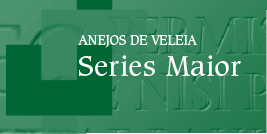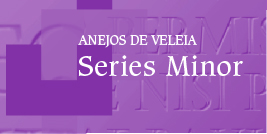Anejos de Veleia (Series <a href="https://web-argitalpena.adm.ehu.es/listaproductos.asp?arbol=05&IdTopics=051330" target="_blank">Maior</a> eta Series <a href="https://web-argitalpena.adm.ehu.es/listaproductos.asp?arbol=05&IdTopics=051335" target="_blank">Minor</a>)
1. Collection guiderlines
The collection of appendices to the 'Veleia' journal is divided into two series (Maior y Minor) and into an Acta that publicises research works on antiquities. The work it includes must always be from original research and not have been published before.
Since their creation in 1985 and 1991 respectively, the first two ('Maior' and 'Minor' Series) have published monographic studies relating to antiquity in each of their disciplines: Prehistory, Ancient History, Archaeology, Indo-European Linguistics, Classic Philology, Law and Classical Thinking in general. They also include tributes to the members of the journal's Editorial Board.
The different monographs published to date have offered new historical, documentary and philological studies, which represent significant advances in both the methodology and knowledge of the different elements from the ancient world. The collection is mainly aimed at researchers from the aforementioned areas, and the general public who are interested in topics related to the prehistory, protohistory and ancient history of the Basque Country, as well as the ancient world's links to the modern day.
A complementary collection to "Anejos de Veleia" named "Acta" was also published up until 2018. In this collection, proceedings of symposia and scientific meetings organized by members of the UPV/EHU Institute of Ancient Studies were published.
2. Start date
Series Maior: 1985
Series Minor: 1991
3. Director
Pilar Ciprés Torres
ORCID ID: 0000-0001-5439-658X
Bachelor of Arts (Philosophy and Letters - History section) from the University of the Basque Country (UPV/EHU), where she obtained her PhD in Philosophy and Letters (History section) in 1990. Lecturer in Ancient History at the Department of Classical Studies of the UPV / EHU; she currently lectures in Ancient History and Epigraphy and Numismatics at the UPV / EHU Faculty of Letters, within the Degrees of History and Art History. She complements this teaching work with lecturing in different PhD programs offered by the UPV / EHU Department of Classical Studies and the UPV / EHU Masters on Research into the Classic World; she was responsible for the latter between February 2014 and April 2017 and was president of its Academic Commission, leading the process of renovation of the governmental recognition of the quality of this Masters.
Her research has been developed along three lines: society in the pre-Roman world of P. Ibérica, ancient geography, in particular, geographical knowledge and the construction of the map of the Iberian Peninsula in Antiquity, and the Roman epigraphy of the Basque Country. She has participated in more than twenty national research projects, and has been a principal investigator in two of them. She has also participated in international projects, participating in several research groups. She is currently participating as a researcher in the Project PGC2018-097703-B-100 “The political construction of Hispania citerior in the High Empire: forms of civic and non-civic organization” funded by MCIU / AEI / FEDER, UE.
Her most relevant publications include the following:
«The political geography of Hispania citerior» in E. Ortiz-de-Urbina (coord.), Ciudadanías, Ciudades y comunidades cívicas en Hispania (de los Flavios a los Severos), Sevilla: Seville University, 2019, 21-44 (ISBN: 978-84-472-2899-7); « Roman epigraphy of the Basque Country: a historiographic revision», Lucentum 37, 2018, 193-211 (ISSN: 0213-2338 / ISSN-e: 1989-9904); «Geographical data in the description of Hispania in Plinio’s Naturalis Historia», Revista de Historiografía 25, 2016, 89-109 (ISSN: 1885-2718); «Onomastics of the roman inscriptions of the Basque Country. Structure of the personal name and legal status», Veleia 23, 2006, 83-126 (ISSN: 0213-2095); «Celtiberia: the creation of a provincial geographical space», Ktèma 18, 1993, 259-291 (ISSN: 0221-5896); War and society in induropean Hispania, Vitoria-Gasteiz: UPV/EHU, 1993 (ISBN: 84-7585-457-5)
She is editor of the following:
Plinio the Old and the construction of Hispania citerior, Vitoria-Gasteiz: UPV/EHU, 2017 (ISBN: 978-84-9082-685-0); «Hispania citerior under Augusto: questions of geography, history and historiography, Veleia 31, 2014, 7-180 (ISSN: 0213-2095).
4. Committee
4.1. Scientific Committee
It is made up of researchers from UPV/EHU and other universities, each with recognised prestige in their respective areas. Its main duty is to make the first decisions and assessments on the originals received in order to proceed with their selection. If the manuscript passes this first assessment, it will then be passed on to other external assessors who will which ones will be published.
The members of the Scientific Committee are as follows:
| M.ª José García Soler (Universidad del País Vasco, UPV-EHU) | mj.garcia@ehu.eus |
| Carlos García Castillero (Universidad del País Vasco, UPV-EHU) | carlos.garcia@ehu.eus |
| Esperanza Osaba García (Universidad del País Vasco, UPV-EHU) | esperanza.osaba@ehu.eus |
| Guadalupe Lopetegi Senperena (Universidad del País Vasco, UPV-EHU) | guadalupe.lopetegi@ehu.eus |
| Mª José Iriarte Chiapusso (Universidad del País Vasco, UPV-EHU) | mariajose.iriarte@ehu.eus |
| Maurizio Campanelli (Universitá di Roma – La Sapienza) | maurizio.campanelli@uniroma1.it |
| Jonathan Edmondson (University of York) | jedmond@yorku.ca |
4.2. Advisory Committee
Its main duty is to advise the Scientific Committee to improve the quality of the collection and where appropriate, make decisions based on their knowledge in certain areas.
Forming part of the Advisory Committee are:
- I. Barandiarán (Professor of Prehistory. UPV/EHU)
- G. Bosinski (Museum für die Archäologie des Eiszeitalters. Neuwied)
- A. Broglio (Dipartimento delle Risorse Naturali e Culturali. Ferrara)
- G. Calboli (Università degli Studi di Bologna)
- A. Carandini (Università degli Studi di Roma «La Sapienza»)
- C. Codoñer (Universidad de Salamanca)
- J. d'Encarnação (Universidade de Coimbra)
- F. J. Fernández Nieto (Universitat de València)
- H. Galsterer (Universität Aachen)
- R. J. Harrison (University of Bristol)
- J. de Hoz (Universidad Complutense. Madrid)
- M. Mazza (Università degli Studi di Roma «La Sapienza»)
- P. Moret (Université Toulouse Jean Jaurès)
- M. Navarro Caballero (Institut Ausonius. CNRS-Université Bordeaux-Montaigne)
- H. Schubart (Deutsches Archäologisches Institut. Madrid)
- F. Sousa (Universidade de Coimbra)
- A. U. Stylow (Deutsches Archäologisches Institut. Madrid)
- V. Valcárcel (Professor of Latin Philology. UPV/EHU)
5. Instructions for authors submitting original manuscripts
6. Information on the manuscript selection process
The initial selection of original documents for the Collection of Appendices to 'Veleia' is done by the Scientific Committee. The Committee assesses the work and issues a reasoned report on its suitability. If this first assessment is negative, it is rejected and the the Editorial Service informs the author of this decision in a reasoned and well-written letter.
If the first assessment is positive, the collection management along with that of the Editorial Service will select four persons as external assessors from specialists of the matter in question. The assessment process will be anonymous, in accordance with the double-blind peer review procedure.
The Editorial Service management will request that the assessors send their report within a period of no longer than sixty days after the original format of the work was sent. If accepted, the author will be informed by via e-mail.
If the two reports issued are favourable, the Scientific Committee will accept publication of the work and, in the event of disagreement between one report and another, the assessment of a third will be requested and, only if this is positive will the work be accepted for publication.
Once the assessment process has ended, the author will be notified of the decision and will be sent (by e-mail) the assessors' reports so that they can view in detail the assessments made by the experts and the relevant corrections, if any. In the event that the manuscript requires corrections, amendments or extensions, the author will be given a maximum period of thirty days to implement them. Once the relevant corrections have been made, which will be clearly outlined in the text, the author will send the manuscript again (according to the collection's standards: https://www.ehu.eus/eu/web/argitalpen-zerbitzua/anejos-de-veleia) to the Management thereof.
After the manuscript has been received in its final version, it will be sent by e-mail to the Editorial Service at UPV/EHU.
The Editorial Service may request a paper copy of the work, if deemed appropriate.


